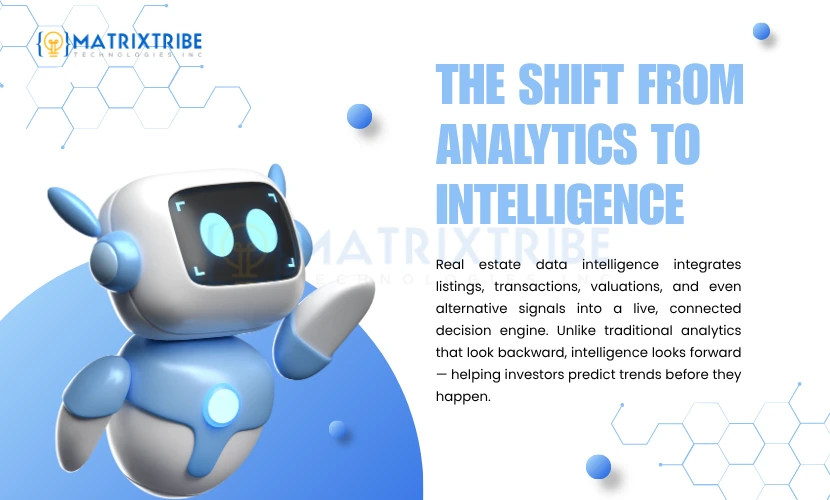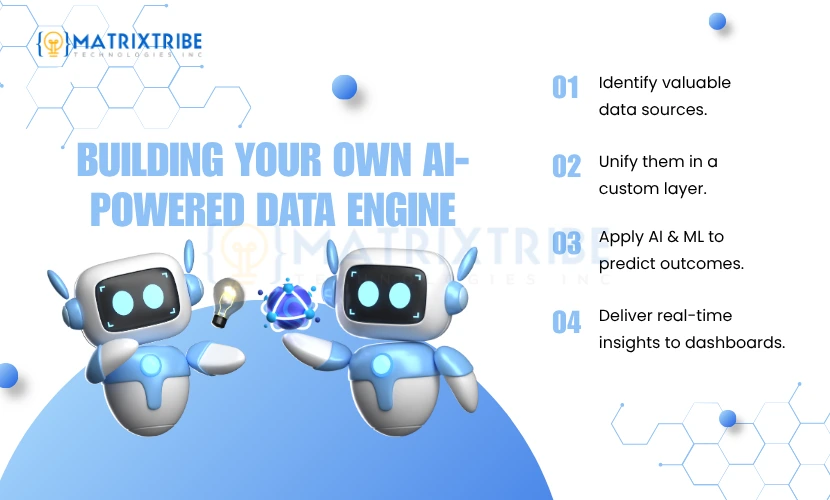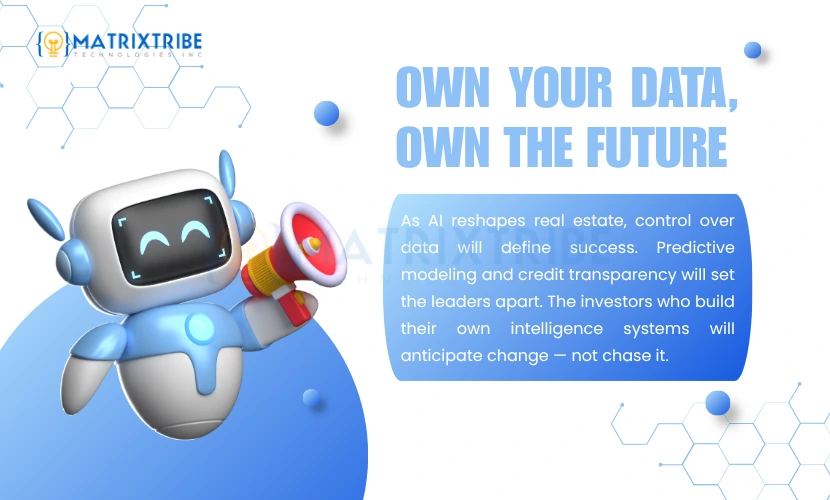

Real Estate
What is a real estate data intelligence pipeline?
November 4, 2025
BLOG
Vision 2026: The Future of Real Estate AI and Intelligence Systems
In 2026, real estate will compete on intelligence, not tools or headcount. This blog outlines how connected data, real-time portfolio intelligence, AI-driven risk detection, and automation will reshape the industry. Static dashboards and manual processes will fade. Firms that invest in governed data systems and intelligence infrastructure will move faster, manage risk better, and outperform in a more demanding market.
Real estate investing has always been based on intuition, spotting patterns, timing the market, and relying on past experience. However, instinct alone will no longer be enough by 2025. Investors today have endless amounts of fragmented data from property records to market feeds and transaction histories. Yet they struggle to make meaningful decisions.
This is where real estate data intelligence pipelines come in. Instead of adding extra dashboards or spreadsheets, they provide you with what you need: a connected system that converts raw data into real-time, actionable investment intelligence.
In this blog, we'll explain what these pipelines are, how they work, and why they're rapidly becoming a competitive advantage for serious investors.

Understanding Real Estate Data Intelligence for Investors
Real estate data intelligence means integrating multiple market data sources, such as listings, transactions, valuations, and alternative signals, into one continuous decision-making stream. It’s not just about collecting data but connecting it so insights flow directly into investment actions.
Traditional real estate analytics looks backward, studying past prices, rental trends, or occupancy rates. Data intelligence, on the other hand, looks forward. It uses predictive models to identify where value is likely to move next, helping investors act before the market does.
For investors, this shift means faster property valuations, stronger underwriting accuracy, and smarter entry and exit timing, the three levers that ultimately define portfolio performance.

The Three Pillars of Real Estate Data Intelligence
Real estate data intelligence rests on core data streams that together transform raw data into actionable investment insight. For investors, mastering the data means faster underwriting, stronger yield forecasting, and earlier access to undervalued opportunities.
Market Data
Market data captures the pulse of the property landscape: rents, transaction prices, absorption rates, and comparable sales. When consolidated through an intelligence pipeline, these signals reveal emerging neighborhoods and pricing anomalies that traditional market reports overlook.
For example, monitoring month-over-month rent trends across micro-markets can flag areas where demand is rising ahead of public recognition. Similarly, aggregating comparable sales data helps investors benchmark acquisition costs against historical and regional averages, leading to more confident, data-backed valuations.
Financial Data
Financial data forms the backbone of investment performance analysis. Tracking property-level metrics such as net operating income (NOI), operating expenses, and capital expenditures allows investors to understand not just where value exists, but how it evolves over time.
When these variables are modeled at scale across an entire portfolio, the intelligence pipeline connects performance with long-term yield projections. Investors gain the ability to simulate how shifts in occupancy and rent growth affect return. Thus, turning static financial snapshots into dynamic forecasting models that guide capital allocation.
Tenant Data
Tenant data provides the most direct view of cash flow stability. Credit score analysis enables investors to assess tenant quality before lease execution, reducing exposure to payment defaults and vacancy-related losses.
By integrating verified tenant credit data with rent rolls and lease performance records, intelligence pipelines help investors quantify risk at both unit and asset levels. This data-driven view strengthens underwriting discipline and enhances predictability across income-producing assets. Hence, providing a crucial advantage in markets defined by volatility and competition.

Why Data Intelligence Matters for Investment Performance
In today’s competitive markets, investment success depends less on access to data and more on how effectively it’s interpreted. Real estate data intelligence turns fragmented datasets into a single decision framework where every acquisition and financing move is guided by measurable insight rather than intuition.
Evidence-Based Deal Sourcing and Valuation Accuracy
Integrating multiple data streams allows investors to validate pricing against real-time market signals and uncover undervalued assets early. Instead of relying on lagging comps, intelligence pipelines surface trends as they form. Hence, supporting faster, evidence-backed deal execution.
Improved Yield Forecasts
Predictive analytics models show variables such as rent growth or returns over time. These forecasts empower investors to fine-tune assumptions and position portfolios for stronger, more resilient yields.
Data-Driven Risk Visibility Before Capital Deployment
The potential risks from income volatility or asset level performance gaps become visible as operational, financial, and tenant data is unified. This clarity enables disciplined underwriting and smarter portfolio diversification.
Transparency for Partners and Investors Through Unified Dashboards
An intelligence pipeline can translate complex data into accessible, real-time dashboards, providing stakeholders with a transparent view of asset performance. This not only strengthens trust but also streamlines reporting across investor relations, acquisitions, and asset management teams.

How Investors Implement Data Intelligence Pipelines
Building a real estate data intelligence pipeline starts with identifying what truly drives value not just collecting more data.
Step 1: Identify Data Sources
Investors begin by mapping key inputs such as rent feeds, market comps, financial statements, and tenant credit APIs.
Step 2: Unify in a Custom Data Layer
These sources are centralized into a unified architecture tailored to the investor’s workflow and portfolio structure.
Step 3: Apply AI and ML Models
Machine learning models analyze trends, forecast yields, and simulate market scenarios, turning static data into strategic insight.
Step 4: Deliver to Dashboards
Insights flow directly into dynamic dashboards, enabling quick, informed decisions on acquisitions, valuations, and asset performance.

The Future of Investment-Grade Data Intelligence
The future of investment-grade data intelligence lies in ownership, not access. Real estate investors are shifting toward systems that let them predict, model, and control analytics instead of renting insights from SaaS vendors. With AI projected to add over US $180 billion annually to the U.S. real estate market, this transformation is already measurable, not hypothetical.
Predictive modeling now enables precise rent and yield forecasting, allowing investors to anticipate market shifts and optimize portfolio timing. Meanwhile, credit transparency adds a powerful risk lens, helping investors evaluate revenue stability before committing capital.
Intelligence pipelines bring this value directly inside the investor’s ecosystem, not outsourced to third-party dashboards. In the next cycle, the edge will belong to those who own their data foundations, using AI-powered intelligence pipelines to anticipate change rather than react to it.

Final Words
In a market defined by speed, precision, and transparency, data ownership has become the new competitive currency for real estate investors. Traditional SaaS tools once offered convenience, but they now limit adaptability and control. Intelligence pipelines, by contrast, empower investors to unify market, financial, and credit data into one predictive ecosystem built around their portfolio logic.
As AI continues to generate billions in measurable real estate value, the firms that internalize these capabilities will outpace those who rent insights from external platforms. The future of investing belongs to those who don’t just access data but truly own and understand it.

Take Control of Your Investment Intelligence
Stop renting insights from third-party platforms. Build your own data foundation with MatrixTribe’s custom intelligence pipelines engineered for real estate investors who demand full visibility, predictive precision, and portfolio control.
Contact us to start building your data advantage today.

Latest Article




